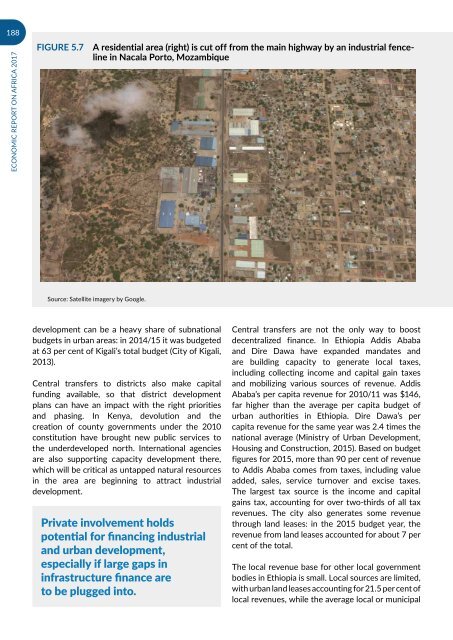URBANIZATION AND INDUSTRIALIZATION
Economic%20Report%20on%20Africa%202017%20UNECA
Economic%20Report%20on%20Africa%202017%20UNECA
Create successful ePaper yourself
Turn your PDF publications into a flip-book with our unique Google optimized e-Paper software.
188<br />
ECONOMIC REPORT ON AFRICA 2017<br />
Figure 5.7<br />
A residential area (right) is cut off from the main highway by an industrial fenceline<br />
in Nacala Porto, Mozambique<br />
Source: Satellite imagery by Google.<br />
development can be a heavy share of subnational<br />
budgets in urban areas: in 2014/15 it was budgeted<br />
at 63 per cent of Kigali’s total budget (City of Kigali,<br />
2013).<br />
Central transfers to districts also make capital<br />
funding available, so that district development<br />
plans can have an impact with the right priorities<br />
and phasing. In Kenya, devolution and the<br />
creation of county governments under the 2010<br />
constitution have brought new public services to<br />
the underdeveloped north. International agencies<br />
are also supporting capacity development there,<br />
which will be critical as untapped natural resources<br />
in the area are beginning to attract industrial<br />
development.<br />
Private involvement holds<br />
potential for financing industrial<br />
and urban development,<br />
especially if large gaps in<br />
infrastructure finance are<br />
to be plugged into.<br />
Central transfers are not the only way to boost<br />
decentralized finance. In Ethiopia Addis Ababa<br />
and Dire Dawa have expanded mandates and<br />
are building capacity to generate local taxes,<br />
including collecting income and capital gain taxes<br />
and mobilizing various sources of revenue. Addis<br />
Ababa’s per capita revenue for 2010/11 was $146,<br />
far higher than the average per capita budget of<br />
urban authorities in Ethiopia. Dire Dawa’s per<br />
capita revenue for the same year was 2.4 times the<br />
national average (Ministry of Urban Development,<br />
Housing and Construction, 2015). Based on budget<br />
figures for 2015, more than 90 per cent of revenue<br />
to Addis Ababa comes from taxes, including value<br />
added, sales, service turnover and excise taxes.<br />
The largest tax source is the income and capital<br />
gains tax, accounting for over two-thirds of all tax<br />
revenues. The city also generates some revenue<br />
through land leases: in the 2015 budget year, the<br />
revenue from land leases accounted for about 7 per<br />
cent of the total.<br />
The local revenue base for other local government<br />
bodies in Ethiopia is small. Local sources are limited,<br />
with urban land leases accounting for 21.5 per cent of<br />
local revenues, while the average local or municipal


